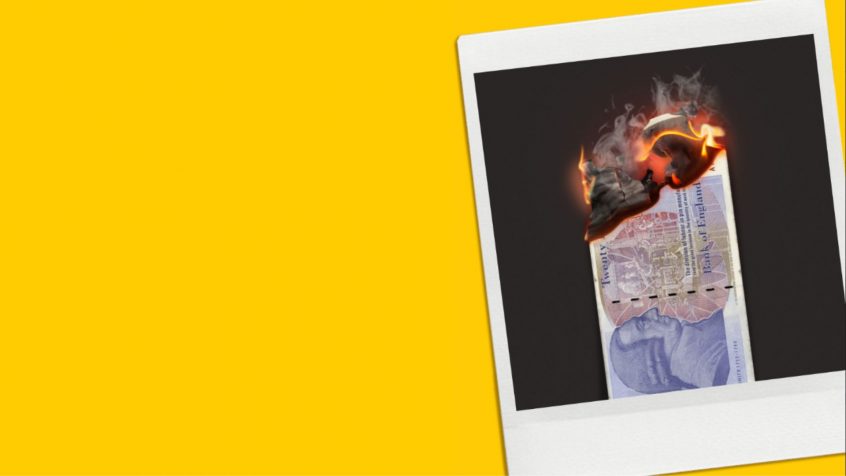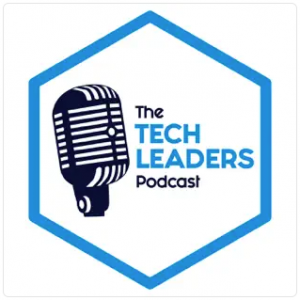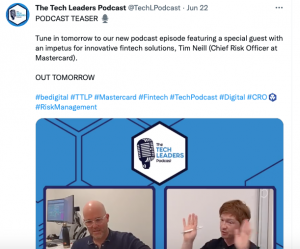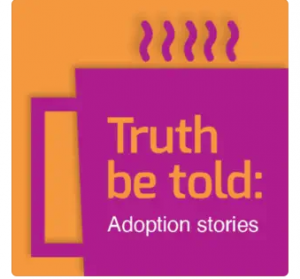Podcasts Are A Complete Waste of Time and Money*


Well that got your attention, didn’t it? From a podcast company nonetheless! Let’s complete the rest of that sentence before we all start hyperventilating… *without proper marketing!
If we’ve said it once, we’ve said it a million times. And it’s on this very subject that our co-founder and creative director Steve Austins delved into during his latest webinar. We’ve popped together his edited highlights to give you all the tips you need to get your podcast marketing off on the right foot.
— A quick disclaimer — you may see some links below to products or other websites. There’s the chance that some of them will pay us a little something when you visit their site, but rest assured, they are only here because we want to chat about them and not because of any mega-bucks deal we have with them!—


Steve’s webinar featured an interview with Amy Stephenson, producer of the Tech Leaders Podcast
And as an aside… The Podcasts are a complete waste of time and money* (*without proper marketing) webinar also featured an interview with The Tech Leaders Podcast producer Amy Stephenson, who also happens to be head of operations at BeDigital. She chatted to Steve about how The Tech Leaders Podcast started, so we’ll be peppering in some handy advice from her throughout!
So you’ve got a podcast…
Yaaaaay! And huge congrats! You’ve done the hard work! Or so you may think… But actually, you’re only half way there…
See, a lot of people assume that after all the blood, sweat and tears (as known as the planning, recording and editing) you can just press publish, relax and watch those listener numbers rise.
Sorry to break it to ya, folks, but that’s only 50% of the job. The other half is podcast marketing; i.e., getting the world to see it and press play.
But don’t fret.
By the end of this blog, you’ll have all the podcast marketing advice any new podcaster could wish for! So let’s get stuck in.
NB: In this blog post, we’ll be talking about organic marketing only – i.e., NOT paid for ads on social channels like Facebook or Instagram, or search engines, paid promotions or plugs on other podcasts. We’re talking about the bits you can do for yourself and that won’t cost you a proverbial dime.
So, let’s take it back to basics. Who is your podcast for?
No, really…WHO is it for? For those of you Bengo Media devotees, you may recognise this point from our 13 Steps to Start A Successful Podcast blog post back in January.
If we had a penny for every time someone said they’re making a podcast ‘for everyone…’
We all want to build the biggest audience we can. But it’s just not realistic to try and appeal to everyone. Your podcast – if it’s going to gain any traction – needs to know its target audience. You can figure this out by homing in on your ideal listener. For example:
- I want to start a podcast for everyone: Far too vague, and any marketing you do will be far too confused to attract any listeners.
- I want to start a podcast for women: 50% better, but still too vague. There are a lot of women in the world…
- I want to start a podcast for women with dogs. Now we’re getting somewhere. But it’s still a long shot.
- I want to start a podcast for women who exercise regularly with their dogs. Excellent. A core demographic of listeners with a specific combination of interests. This makes it much easier to appeal to this group with a podcast that speaks directly to them.
Talk to them!
The next step is to figure out how to find this listener. You want to speak to them as much as possible to gain an insight into what they care about. Learn what’s going to motivate them to listen. Then, crucially, what kind of podcast they would share with their friends.
There are a few ways you can access this kind of vital info:
- In-person: If you already know someone in the niche bracket you’re appealing to, talk to them over a coffee and find out what they listen to, where they do it and what they’re looking for.
- Email / questionnaire: A great way of reaching a broad network of people online.
- Facebook groups: The search and FAQs sections of Facebook groups within your specific niche are a goldmine of valuable information. Here you can find out what kinds of things people are curious about and tailor your marketing to reach them.
- SEO/Google search: Everyone’s going mad for SEO, and for good reason too. Knowing what people type into search engines is dynamite for any marketing strategy.
Once you know exactly who your target listener is, you can start to devise a podcast marketing plan to appeal directly to that person.
Of course, there’s always the chance that you’ll end up appealing to a group of people you didn’t predict. Amy from The Tech Leaders Podcast says they ended up getting into Eswatini’s (formerly Swaziland) Apple Podcasts Top 50. A bit of a shock, but a welcome one!
Anyway, if you’re not sure what a podcast marketing plan entails, that’s just as well…cause we’ve got a handy 5-point checklist for you coming up next.
Get your marketing done E.A.R.L.Y. to avoid disappointment
This nifty little mnemonic we came up with will help you market your podcast to the right people in the right places, and it stands for:
Engagement
The best marketing has been, and always will be, word-of-mouth: someone liking your content so much that they risk their reputation to align themselves with you.
Getting your listeners to tell their friends and family “check out this podcast” is the ultimate success you can have as a podcaster. So – how do you get that to happen?
Well, every successful podcast needs to feel like an intimate chat with your listener. They need to feel like you are speaking to them and them only, as that’s what will keep their attention and boost engagement.
Think about all your favourite podcasts and what makes them special. Often it’s great content presented as engaging conversation. It’s a one to one medium after all.
Speaking of which… once someone has stuck their neck out for you, make sure your podcast is easy to find for their friend – no matter where your soon-to-be new listener is coming from. Have a profile on every social network, use your podcast hosting platform to register with as many podcast directories as you can.
At a bare minimum, you should be looking at: Apple Podcasts, Spotify, Google Podcasts, Amazon, and increasingly, YouTube (more on that curve-ball later!). Create a simple website with episode listings, an embedded player and your contact details (again, some podcast hosting sites will give you a page of your own if being your own web designer is a step too far) and get your podcast a Podfollow link…
Artwork
Unlike TV or radio, nobody stumbles on a podcast. Either someone recommends one or listeners find them through browsing Apple Podcasts or Spotify just for something new or in a specific area. And there are 4 million podcasts out there (and about 65 million episodes), meaning positioning among them is key.
Some people underestimate the power of artwork and descriptions and leave them right to the last minute. Big mistake! Crafting thought-out cover art and a snappy descriptor that explains your podcast succinctly will make heaps of difference once you press publish.
For reference, let’s look at a great example: On My Last Eggs is a podcast all about the onset of the menopause → 

To start it’s a demonstration of how a play on words can lead to a memorable name. Next, the artwork – tangled earphones in the shape of female reproductive organs – is simple but so so clever. Finally, the description gives us a brilliant insight into the content with just 43 words –
Rachel New is literally on her last eggs, in the wild throws of perimenopause like millions of other women around the world.
This podcast lifts the lid on that whole messy, confusing journey with the help of experts and conversations with menopausal celebrities.
If you’re a woman going through this stage of your life, you’d be pretty convinced this podcast is for you, even before you press play.
Repurpose… your podcast content
When it comes to podcast marketing on social media platforms, there’s one phrase that’s guaranteed never to build a following, and that’s “Check out my new podcast!”
Sorry folks, but this just won’t cut it beyond the first episode. So what can we use instead? Your existing content of course!
Think of your audio or audiovisual podcast like a Russian doll. Inside lay lots of little nesting dolls. These nesting dolls contain tons of marketing potential…if you repurpose them correctly on social media. That means turning them into short clips, audiograms, stories, quote cards, slideshows and more.


The Tech Leaders Podcast savvily repurposes its video content for Twitter, YouTube and Instagram
Of course, if your podcast is the product of an existing company or organisation, it makes sense to utilise their reach as much as possible. Producer Amy says BeDigital, the company that spawned The Tech Leaders Podcast, has been crucial for branding: “It acts as a conversation-starter and leverage. We can say ‘did you know we’ve got a podcast too?’ to our clients and market it that way.”
You’ll find that few people want to click straight through from a social media post to listen to a podcast. So this type of marketing helps build support online meaning that, later on, people will seek you out.
It’s also a great idea to utilise the social profile’s of your guests when possible. Asking them to share your repurposed content broadens your reach and gets their audience aware of you too!
Long-term
Unless your podcast is specifically topical, you want to create content that will still be relevant in a year’s time (or more) so that your audience can continue to grow.


Take our word for it: we made a podcast for the National Adoption Service in Wales in 2020 called Truth Be Told: Adoption Stories, which listens to adoptive parents speaking about their experiences.
In the first few weeks after publishing, it did moderately well. But 18 months later, we were pleased to see that it was still receiving excellent download numbers each month. Why is this?
Because the content is ‘evergreen’, meaning it stays relevant year after year. The continuing popularity of this podcast shows that many listeners are still seeking it out and enjoying it long after publication because it has something universal to offer; namely, the shared experiences of other adoptive parents.
Amy from Tech Leaders also has big plans for long-term growth: “We recently did a series on women in tech, which was a BIG hit. In the future, we’re planning a series with universities, focusing on getting tech into education. Someone said to us at the start, if you’re not going to aim for 100 episodes then don’t bother…at the moment we’re about halfway, so we’ve got lots of ideas coming up about how to get to that 100 mark.”
Obviously, not every podcast needs to plan 100 episodes in advance. But making sure you’ve got a long-term plan for your content is important to keep listeners coming back each week.
YouTube
Last but not least, get your podcast onto YouTube.
Yep – you read that right! According to Ofcom, 31% of people in the UK now say they get their podcast dose from YouTube – and in the US, one in two who go to YouTube for their podcasts won’t go anywhere else to find them. That’s an incredible shift in an industry historically dominated by audio streaming platforms. So, what do we suggest?
First of all, make sure your podcast recording platform can also record video (check out our blog ‘No Studio? No Problem!’). And then we’d also recommend revisiting point 4 (Repurposing) when it comes to YouTube too. The Tech Leaders Podcast cannily promotes itself by sharing 2-3 minute video excerpts of recordings on YouTube. Amy says: “We record about 45 minutes of content each time, but cut it down and repurpose clips for marketing.”


Rob Brydon’s podcast utilises YouTube’s format by posting 15-minute clip
Another good example is Rob Brydon’s podcast Brydon &, where longer video clips from each episode (10-15mins or so like this one!) are uploaded to YouTube. This is a particularly savvy example of repurposing your content and optimising it for YouTube. That’s because it opens up the podcast to a whole new audience who might not even think to browse audio only sites to find new material.
How Bengo Can Help
As always, we get that everyone coming to this page has different needs, different time constraints and different levels of confidence in their own abilities.
If you love the idea of podcasting and think it might be something you want to explore further, we’re always here to help. From taking on full on production, training you to do it yourself or even just taking the fiddly, techy and time consuming bits off your hands (like the recording and editing!), we’re happy to chat. Go ahead and book a complimentary discovery call with Co-Founder and Creative Director Steve and let’s see where it goes.
And for those of you that have already bitten the bullet and joined the podcasting fraternity – we salute you and are here for you too. Contact us, or book in a call with Steve, if you’d like us to give your podcast a little health check to help you take it to the next level, or get it video enabled to help you reach those loyal YouTubers. We can help you optimise and repurpose all your content so that it stands out in the listings and makes a splash.
You might not have got that far, and that’s okay too. Take a look at our ‘13 Steps to a Successful Podcast‘ blog and download the handy checklist that comes with it and then book in a call with Steve to chat things through.
Summary
So, to conclude this mega-download of podcast marketing tips and tricks, here are the main points:
- Figure out who your target audience is and research appropriately
- Plan your marketing EARLY! Devise a strategy that optimises your content across several platforms.
- Contact us if you’d like a helping hand 🙂
Find out more about our podcast services, including podcast marketing & PR and video podcasts.
